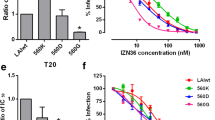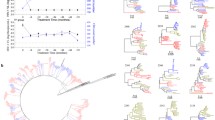Abstract
HIV-1 gp41 plays a key role in viral entry. The insertion of Thr at position 4 and Met/Val/Phe substitutions at position 7 are frequently observed in the fusion peptide (FP) motif of gp41 without major enfuvirtide resistance associated with mutation in heptad repeats 1/2 (HR1/2) of HIV-1 isolates from Korean patients. Here, the influence of these mutations on their biological function was evaluated by employing HIV-1 variants with mutant FPs as shown previously and with recombinant HIV-1 using the env genes of 20 HIV-1 isolates from Korean patients. In an infectivity assay, all FP mutants showed lower infectivity than the wild-type NL4-3. In particular, the substitutions at position 7 led to much greater reductions in infectivity than the insertions at position 4. Nevertheless, the replication kinetics of most mutants were similar to those of the wild type, except that the FP mutants with an Ile insertion at position 4 and a Phe substitution at position 7 showed reduced replication. Moreover, most point mutants showed lower IC50 values for enfuvirtide than the wild type, whereas the L7M substitution resulted in a slightly increased IC50 value. The infectivity using the HIV-1 env recombinant viruses decreased in 14 cases but increased slightly in six cases compared with the wild type. Most recombinants were more susceptible to enfuvirtide than the wild type, except for three recombinants that showed slight resistance. Our findings may help to explain the potential mechanisms corresponding to the natural polymorphism of gp41 and to predict the efficiency of enfuvirtide in treatment of HIV-1-infected patients in Korea.



Similar content being viewed by others
References
Douek DC, Picker LJ, Koup RA (2003) T cell dynamics in HIV-1 infection. Annu Rev Immunol 21:265–304
Wensing AM, Calvez V, Gunthard HF, Johnson VA, Paredes R, Pillay D, Shafer RW, Richman DD (2014) 2014 Update of the drug resistance mutations in HIV-1. Top Antivir Med 22:642–650
Wilen CB, Tilton JC, Doms RW (2012) HIV: cell binding and entry. Cold Spring Harb Perspect Med 2:1–14
Hill MD, Lorenzo E, Kumar A (2004) Changes in the human immunodeficiency virus V3 region that correspond with disease progression: a meta-analysis. Virus Res 106:27–33
Lohrengel S, Hermann F, Hagmann I, Oberwinkler H, Scrivano L, Hoffmann C, von Laer D, Dittmar MT (2005) Determinants of human immunodeficiency virus type 1 resistance to membrane-anchored gp41-derived peptides. J Virol 79:10237–10246
Sagar M, Wu X, Lee S, Overbaugh J (2006) Human immunodeficiency virus type 1 V1-V2 envelope loop sequences expand and add glycosylation sites over the course of infection, and these modifications affect antibody neutralization sensitivity. J Virol 80:9586–9598
Morikawa Y, Barsov E, Jones I (1993) Legitimate and illegitimate cleavage of human immunodeficiency virus glycoproteins by furin. J Virol 67:3601–3604
Pessoa LS, Valadao AL, Abreu CM, Calazans AR, Martins AN, Azevedo SS, Couto-Fernandez JC, Azevedo MC, Tanuri A (2011) Genotypic analysis of the gp41 HR1 region from HIV-1 isolates from enfuvirtide-treated and untreated patients. J Acquir Immune Defic Syndr 57(Suppl 3):S197–S201
Miyamoto F, Kodama EN (2012) Novel HIV-1 fusion inhibition peptides: designing the next generation of drugs. Antivir Chem Chemother 22:151–158
Wilen CB, Tilton JC, Doms RW (2012) Molecular mechanisms of HIV entry. Adv Exp Med Biol 726:223–242
Kilby JM, Eron JJ (2003) Novel therapies based on mechanisms of HIV-1 cell entry. N Engl J Med 348:2228–2238
Cooper DA, Lange JM (2004) Peptide inhibitors of virus-cell fusion: enfuvirtide as a case study in clinical discovery and development. Lancet Infect Dis 4:426–436
Greenberg ML, Cammack N (2004) Resistance to enfuvirtide, the first HIV fusion inhibitor. J Antimicrob Chemother 54:333–340
Trivedi VD, Cheng SF, Wu CW, Karthikeyan R, Chen CJ, Chang DK (2003) The LLSGIV stretch of the N-terminal region of HIV-1 gp41 is critical for binding to a model peptide, T20. Protein Eng 16:311–317
Wei X, Decker JM, Liu H, Zhang Z, Arani RB, Kilby JM, Saag MS, Wu X, Shaw GM, Kappes JC (2002) Emergence of resistant human immunodeficiency virus type 1 in patients receiving fusion inhibitor (T-20) monotherapy. Antimicrob Agents Chemother 46:1896–1905
Poveda E, Rodes B, Toro C, Martin-Carbonero L, Gonzalez-Lahoz J, Soriano V (2002) Evolution of the gp41 env region in HIV-infected patients receiving T-20, a fusion inhibitor. AIDS 16:1959–1961
Zollner B, Feucht HH, Schroter M, Schafer P, Plettenberg A, Stoehr A, Laufs R (2001) Primary genotypic resistance of HIV-1 to the fusion inhibitor T-20 in long-term infected patients. AIDS 15:935–936
Mink M, Mosier SM, Janumpalli S, Davison D, Jin L, Melby T, Sista P, Erickson J, Lambert D, Stanfield-Oakley SA, Salgo M, Cammack N, Matthews T, Greenberg ML (2005) Impact of human immunodeficiency virus type 1 gp41 amino acid substitutions selected during enfuvirtide treatment on gp41 binding and antiviral potency of enfuvirtide in vitro. J Virol 79:12447–12454
Lu J, Sista P, Giguel F, Greenberg M, Kuritzkes DR (2004) Relative replicative fitness of human immunodeficiency virus type 1 mutants resistant to enfuvirtide (T-20). J Virol 78:4628–4637
Xu L, Pozniak A, Wildfire A, Stanfield-Oakley SA, Mosier SM, Ratcliffe D, Workman J, Joall A, Myers R, Smit E, Cane PA, Greenberg ML, Pillay D (2005) Emergence and evolution of enfuvirtide resistance following long-term therapy involves heptad repeat 2 mutations within gp41. Antimicrob Agents Chemother 49:1113–1119
Jang DH, Yoon CH, Choi BS, Chung YS, Kim HY, Chi SG, Kim SS (2014) Characterization of Gp41 polymorphisms in the fusion peptide domain and T-20 (Enfuvirtide) resistance-associated regions in Korean HIV-1 isolates. J Korean Med Sci 29:456–459
Morozov VA, Morozov AV, Schurmann D, Jessen H, Kucherer C (2007) Transmembrane protein polymorphisms and resistance to T-20 (Enfuvirtide, Fuzeon) in HIV-1 infected therapy-naive seroconverters and AIDS patients under HAART-T-20 therapy. Virus Genes 35:167–174
Reis MN, de Alcantara KC, Cardoso LP, Stefani MM (2014) Polymorphisms in the HIV-1 gp41 env gene, natural resistance to enfuvirtide (T-20) and pol resistance among pregnant Brazilian women. J Med Virol 86:8–17
Chong H, Xu S, Zhang C, Nie J, Wang Y (2009) Mutation L33M in the HR1 region of HIV-1 gp41 may play a role in T20 resistance. J Clin Virol 45:255–258
Pritsker M, Rucker J, Hoffman TL, Doms RW, Shai Y (1999) Effect of nonpolar substitutions of the conserved Phe11 in the fusion peptide of HIV-1 gp41 on its function, structure, and organization in membranes. Biochemistry 38:11359–11371
Kim HY, Choi BS, Kim SS, Roh TY, Park J, Yoon CH (2014) NUCKS1, a novel Tat coactivator, plays a crucial role in HIV-1 replication by increasing Tat-mediated viral transcription on the HIV-1 LTR promoter. Retrovirology 11:67
Liu Z, Shan M, Li L, Lu L, Meng S, Chen C, He Y, Jiang S, Zhang L (2011) In vitro selection and characterization of HIV-1 variants with increased resistance to sifuvirtide, a novel HIV-1 fusion inhibitor. J Biol Chem 286:3277–3287
Kim GJ, Nam JG, Shin BG, Kee MK, Kim EJ, Lee JS, Kim SS (2008) National survey of prevalent HIV strains: limited genetic variation of Korean HIV-1 clade B within the population of Korean men who have sex with men. J Acquir Immune Defic Syndr 48:127–132
Delahunty MD, Rhee I, Freed EO, Bonifacino JS (1996) Mutational analysis of the fusion peptide of the human immunodeficiency virus type 1: identification of critical glycine residues. Virology 218:94–102
Freed EO, Myers DJ, Risser R (1990) Characterization of the fusion domain of the human immunodeficiency virus type 1 envelope glycoprotein gp41. Proc Natl Acad Sci USA 87:4650–4654
Freed EO, Delwart EL, Buchschacher GL Jr, Panganiban AT (1992) A mutation in the human immunodeficiency virus type 1 transmembrane glycoprotein gp41 dominantly interferes with fusion and infectivity. Proc Natl Acad Sci USA 89:70–74
Mobley PW, Waring AJ, Sherman MA, Gordon LM (1999) Membrane interactions of the synthetic N-terminal peptide of HIV-1 gp41 and its structural analogs. Biochim Biophys Acta 1418:1–18
Qiu S, Yi H, Hu J, Cao Z, Wu Y, Li W (2012) The binding mode of fusion inhibitor T20 onto HIV-1 gp41 and relevant T20-resistant mechanisms explored by computational study. Curr HIV Res 10:182–194
Acknowledgments
This work was supported by an intramural grant from the Korea National Institute of Health (Grant Number: 2013-N51004-00).
Author information
Authors and Affiliations
Corresponding author
Ethics declarations
Conflicts of interest
The authors declare that they have no conflict of interest.
Additional information
Y. Shin and C.-H. Yoon contributed equally to this work.
Electronic supplementary material
Below is the link to the electronic supplementary material.
Rights and permissions
About this article
Cite this article
Shin, Y., Yoon, CH., Yang, HJ. et al. Functional characteristics of the natural polymorphisms of HIV-1 gp41 in HIV-1 isolates from enfuvirtide-naïve Korean patients. Arch Virol 161, 1547–1557 (2016). https://doi.org/10.1007/s00705-016-2807-x
Received:
Accepted:
Published:
Issue Date:
DOI: https://doi.org/10.1007/s00705-016-2807-x




